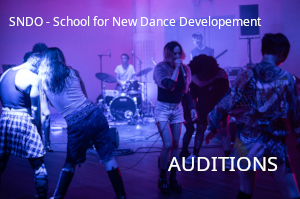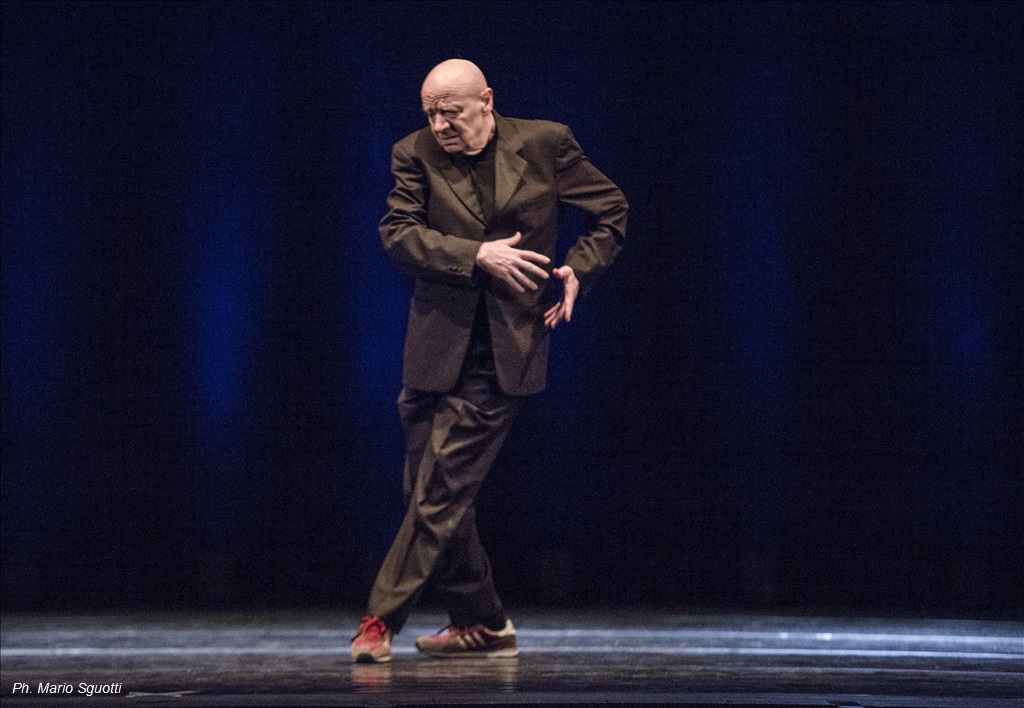Johan Inger: a new full length creation for Aterballetto
"Don Juan" in Freudian overtones
13/10/2020
On the verge of completion, Johan Inger’s eagerly anticipated full-length 2020 production for Aterballetto, Don Juan, was stopped in its tracks by the coronavirus – as we all were. As we await further developments and look forward to its world premiere, originally slated for the Ravenna Festival, we had a video call with the choreographer to ask him about the project, and much more: his early career, his elective affinities and his poetics. A prolific dancemaker with his roots in abstract dance, Inger is also an accomplished narrative choreographer, as shown by hits such as the Benois-winning Carmen, created for the Spanish National Ballet; Peer Gynt, created for Ballett Theater Basel, and a version of Petrushka for Ballets de Monte-Carlo. A refined, sensitive observer of the human soul, he has now turned his gaze to the controversial figure of Don Giovanni. Using the Spanish title – after all, Inger lives in Seville – the Swedish choreographer talks to us in Freudian terms about a man traumatised by maternal abandonment, and his incapacity for love.
Inger, given the current pandemic that forced you to interrupt work on your production of “Don Juan” with Aterballetto, do you think you’ll be able to unveil the work on 19 June at the Ravenna Festival?
My feeling is - though I hope I’m wrong - that it’s not going to premiere in June. The world situation is too complicated. I still need four weeks of work on it: three to finish the choreography, one for setting up the production. The way things are now, it’s all on hold; I can’t even travel. I mean here in Spain (and where you are I imagine) I’m not allowed to leave the house. I hope things will open up in May. The idea is we try to finish the work as soon as possible; then at least it’s finished and can premiere… maybe at the Ravenna Festival as planned, and if so that would be fantastic. I feel for the company and I feel their concern: this production is a big investment for Aterballetto and they plan to perform it a lot on tour next year.
What made you choose to tackle the character of Don Giovanni?
I think his character is especially interesting today. Going beyond the age-old theme of the “serial womaniser”, today the #MeToo revolution and the constant news reports of about abuse and violence against women make him more relevant than ever.
Which literary sources did you use, and who is your Don Giovanni?
With the dramaturg Gregor Acuña-Pohl, we discussed it a lot, we read and re-read Brecht, Molière and Tirso de Molina. But what really inspired our libretto more than anything was the Suzanne Lilar book Le Burlador, which is a feminist reimagining of the story of Don Giovanni. Who is my Don Juan? A very real character, a man who has suffered the huge trauma of maternal abandonment.
So it’s a psychoanalytical take on the story?
Yes, partly. It’s as though with every encounter Don Giovanni is seeking his mother, that’s why he cannot commit to any relationship. So he is very, hollow, very shallow and sad… luckily he always has his servant with him.
You mean Leporello?
Yes, we just called him Leo but I don’t want to give too much away. In our version he’s really an alter ego of Don Giovanni.
About the music, are you referring the versions by Mozart and Gluck or did you take a different route?
The music for Don Juan is an original composition by Marc Alvarez. The score has melodic references to various past versions, including Gluck, but the overall result will be totally new.
Could you tell us about your approach to the choreographic process, how you work with the dancers in the studio?
I always go into the studio with very clear ideas, but I don’t prepare steps beforehand. When I meet the dancers I invite them to share my thoughts about where we need to go, but I don’t give a lot of improvisational tasks.
Do you remember when you first felt the desire to compose choreography?
As a young kid I loved to put on my headphones with my father’s stereo and listen to music, it was always very inspiring: I got a lot of images and ideas, and I’d be dancing… Then I started to study dance and I danced for many years, but I always liked improvising on my own and trying things. I never showed anything to anyone though, not until I came to the Nederlands Dance Theatre - because at the NDT everybody was choreographing [smiles]. In the yearly workshop, everybody did a piece. So I thought I’d try it as well. I did a very, very short work, because I thought, “If it’s bad, at least it’s over fast”! One very important factor was working with Jiří [Kylián, Ed.]. He always invited us to suggest, to participate. He made you feel like a collaborator in the choreographic process, so I got more in touch with my creative side working with him. After three years of workshops they asked me if I wanted to do a piece for NDT2. And that was the beginning of it.
Has your approach to choreography changed over the years?
It has and it hasn’t. I think as a young choreographer you try lots of different ideas; you don’t know who you are and you don’t really know your strengths and weaknesses and what your language is. So it takes a long time to figure out, it’s very much hit and miss: you try something and it fails; or you feel “that’s not really me, even though it comes from me”. At some point, I started to mix the experience that I had discovered in the abstract, more physical works, with a theatricality that I think is a part of me. Somewhere I am some form of storyteller.
One of your statements that’s often quoted is “every piece is a journey”. Towards what?
I love to see work that really touches me, that makes me laugh or cry, that makes me think and question things… That’s what I mean by a journey. A journey means exploring the broad spectrum of … not humanity, because that sounds so pretentious, but of human beings. I try to be as honest as I can, and I try to find the honesty in what it means to be human beings. That’s sort of my mantra.
On several occasions it’s been music that inspired your most successful pieces, like "Bliss"(Keith Jarrett), or "I New Then" (Van Morrison). How does your choreographic process change when there is a plot to tell like in "Carmen" or "Don Juan”?
It changes in a sense. If I have a very clear script, a clear dramaturgy, I know I have to tell the story from beginning to end. Sometimes you have existing music, like in Carmen you have Shchedrin or Bizet, and then of course the music is describing very clear situations. In that sense, yes. I’m very clear where I need to go, “Now we go here, I have to explain this and I have to capture that feeling”. It’s not always easy, but there is a certain relief because you’re leaning on a story, you’re not making it up as you go. Making a slightly more abstract work like “I New Then” or “Bliss” is different. Bliss was very much about responding to the music, it was trying to capture the feeling, the essence of Keith Jarrett playing
You gave up directing the Cullberg Ballet a few years ago, and then you went freelance. Is freelance choreography more difficult than being able to develop your ideas with your own company?
There are two sides to every coin. I directed the Cullberg for five years so I’ve been able to weigh the good with the bad. With directing, creatively it was fantastic. The dancers got to know me very well, so it was a very effective way of working. But then, of course, you have the “price” of directing people on a daily basis in practical terms, which I found a little less interesting, and maybe also a little in conflict with choreographing. Sometimes I think “Oh yeah, maybe it would be nice to try to have a group again”, but then I try to remember my time there and I think, there’s probably a better solution. Like being the ‘house choreographer’, so I could advise and guide the dancers, but only focus on what I’m good at and leave the other responsibilities to professionals who are certainly more suited to them than a choreographer.
Can you tell us about your longstanding relationship with Aterballetto, and also Ballett Basel…
These things are both professional, and also very personal. You just feel a bit more at home in certain places than in others, and you don’t know why. With Aterballetto, I felt that they had just started to recover from the loss of Bigonzetti, and were trying to find a new identity. I thought it would be interesting to be a part of that, and the feeling was mutual. I always felt very, very appreciated in many ways, by the dancers and the people working there.
Do you already have new commissions for 2021? If so, for which companies?
Yes, next season I will do a work for the Gothenburg Dance Company in Sweden, a new half-evening piece. I will start creating in January and the premiere is in March 2021. It will be based on human ambition – how we constantly try to move and grow and expand, and find ourselves, struggling to achieve our goals.
I’m still looking for the music. I have to say I’ve now been sitting in this quarantine for four weeks and I thought I’d get super creative but I’m not [laughs]. I’m looking for music but I’m not really inspired at the moment, I don’t know why.
"Don Juan" tour
Paris – Théâtre de Chaillot (F)
14 October 2020 h 20.30
15 October 2020 h 19.30
16 October 2020 h 20.30
17 October 2020 h 15.30 and 20.30
Festspielhaus St. Pölten (AT)
24 October 2020 h 19.30
Prato – Teatro Metastasio (I)
29-30 October 2020 h 20.45
31 October 2020 h 19.30
01 November 2020 h 16.30
Opéra de Saint-Étienne (F)
4 Dicembre / December
Ludwigsburg - Forum am Schlosspark (D)
15 Gennaio / January 2021 h 20.00
16 Gennaio / January 2021 h 19.00
Parma – Teatro Regio (I)
30 Gennaio / January 2021
Schaffhausen - Stadttheater Schaffhausen (CH)
11 Marzo / March 2021 h 19.30
Lörrach – Burghof (D)
14 Marzo / March 2021 h 20.00
Schweinfurt – Theater der Stadt (D)
19-20 Marzo / March 2021 h 19.30
Aschaffenburg - Stadttheater Aschaffenburg (D)
27 Marzo / March 2021 h 20.00
Vaison-la-Romaine – Vaison Danses (F)
21 Luglio / July 2021
© All rights reserved










